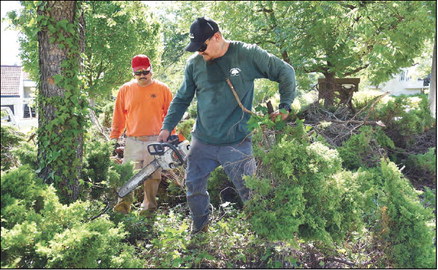
Weeds and trees must be trimmed by June 30
Staff writer
The sounds of chainsaws ripping tree branches, the sight of small frontend loaders grabbing clumps of encroaching bushes and shrubs, and the quiet whine of weed whackers attacking parcels overrun with tall, dry grasses are common around Rossmoor in mid- to late June.
All this work – during the week of June 10, much of it being done in the 100-plus-degree heat – is ahead of the end-of-the-month deadline for properties in Rossmoor and beyond to create as much “defensible space” around buildings and roadways as possible to protect them from the potential spread of wildfires from nearby open spaces.
While this trimming of tree branches, field weeds and stubborn bushes is a campaign every year in the East Bay’s dry Mediterranean summer climate and its hot winds, it’s FIRE: Landscapers prep for fire season by trimming trees
an especially urgent effort this year. Heavy winter and late spring rains have significantly increased the amount and density of vegetation growth, which since the last of May rains has gone from a lush green to a tinder-dry brown, ready to burn.
“This means more fuel and longer-burning, tougher-tofight fires, making it more important than ever that property owners take weed abatement and defensible space requirements uber-seriously,” said Steve Hill, a spokesman for the Contra Costa County Fire Protection District (CCCFPD), which covers Walnut Creek and thus Rossmoor.
The defensible-space requirements, according to the fire protection district, include trimming weeds and grasses to no higher than 3 inches (or removing them entirely where appropriate); making sure tree branches drop no closer to the ground than 10 feet, so grass fires are less likely to spread upward; thinning tree branch networks to make the trees more resistant to intense fires; breaking up clusters of bushes and other ground-based plants (as opposed to trees); and removing any potentially flammable non-vegetative material, including old wood, wooden objects or other debris, from one‘s property.
That increased (and later) rainfall has also resulted in extended deadlines to comply with fire district mandates for doing sufficient abatement to create “defensible space” around structures on private and public property. The deadline for east and central Contra Costa County was June 16, and is June 30 for West County.
The deadline remains June 30 within Rossmoor, said Rebecca Pollon, Rossmoor’s landscape manager.
The “rainy season” officially runs from July 1 through June 30, though in Northern California most of that rain usually falls from October into April or May. The Contra Costa County Flood Control and Water Conservation District has rain gauges throughout the county (http:// www.ccflood.us/rainmap.html), including one in Rossmoor. That collection point, so far in the 2018-19 rainy season, has registered 33.17 inches. That compares with 20.22 inches measured at the same time last year, said Mark Boucher, senior hydrologist with the flood FIRE: Defensible space is crucial
control district. Of that 2018-19 amount, 2.83 inches has fallen since May 11, as compared with zero between May 11 and June 11, 2018.
The inspections are carried out with CCCFPD directives in mind to create 100 feet of “defensible space” around homes, businesses and other structures, and at least 30 feet from roadways and parking areas. This is most critical on the perimeter of Rossmoor, the community’s outer reaches being a prime example of “wildland urban interface,” where humans’ developed, manicured settlement meets nature’s unkempt, and fire-fuel- rich glory.
While the Mutual landscape reps and MOD landscape supervisors generally do initial inspections of individual properties, Pollon said, the fire department does the primary, official inspections. Hill said the CCCFPD has an inspector dedicated to Rossmoor, checking all buildings externally, walking the exterior of every structure to examine every potential way it could be susceptible to fire. These inspections started a couple of months ago, Hill said.
Hill said that, typically, each property is formally inspected by his department only one time, though occasional extenuating circumstances can mean multiple inspections. But the dedicated Rossmoor inspector will continue beyond June 30 as needed to follow up on corrective actions for violations noted during those inspections. The inspector will also be available to answer questions and monitor progress on weed abatement and defensible space work, Hill said.
Though the fire department sets the rules for compliance, any of Rossmoor’s Mutuals can elect to go “above and beyond” in requiring additional measures to reduce vulnerability to fire, Pollon said. Those extra requirements often include removal of short but spreading juniper bushes, as well as more stringent building clearance of trees and shrubs and additional brush clearing beyond the fire department’s guidelines.
Rossmoor residents are not responsible for doing any of the abatement work themselves, said Paul Donner, Rossmoor’s director of Mutual operations.
“This is the responsibility of the Mutual,” Donner said. “Residents should not do this work themselves.”


